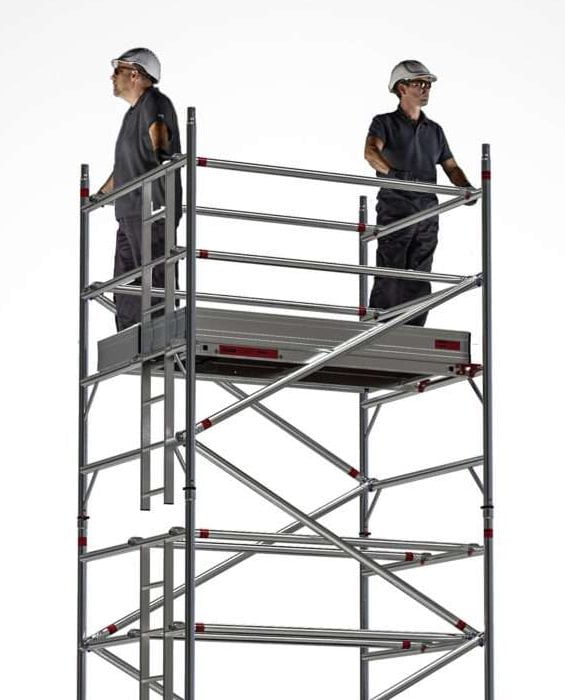Temporary Roof Scaffolding for Your Construction or Renovation Project
Checking Out the Various Kinds Of Scaffolding Made Use Of in Construction Jobs
The construction sector depends heavily on various sorts of scaffolding to fulfill specific project requirements, each offering distinct benefits and applications. Typical framework scaffolding offers a tough structure for basic tasks, while put on hold scaffolding is vital for work with high-rise frameworks. Other choices, such as system and rolling scaffolding, deal with effectiveness and wheelchair, respectively. The cantilever variant confirms vital in urban settings where space is constrained. Recognizing the nuances of these scaffolding kinds is essential for maximizing safety and security and performance on building websites, motivating a closer assessment of their unique attributes and applications.

Traditional Framework Scaffolding
Standard structure scaffolding is one of the most widely utilized approaches in the building sector because of its toughness and versatility. This system includes upright and straight frameworks that are set up to produce a stable system for materials and employees. The main parts consist of vertical posts, horizontal journals, and diagonal dental braces, which together give a strong structure that can sustain considerable lots.
Among the essential benefits of traditional framework scaffolding is its flexibility to various building and construction projects, varying from residential buildings to big commercial structures. The modular style permits for simple setting up and disassembly, making it reliable for both long-lasting and temporary projects. Furthermore, the system can be personalized in elevation and width, suiting various structure designs and site problems.
Safety and security is paramount in scaffolding applications, and conventional frame systems are geared up with guardrails and toe boards to stop falls and make certain employee defense. Furthermore, normal evaluations and adherence to security guidelines are vital in keeping the integrity of the scaffold. Overall, traditional framework scaffolding stays a fundamental choice in the building market, offering a trustworthy platform for labor and enhancing general project efficiency

Suspended Scaffolding
Suspended scaffolding offers an unique service for building and construction jobs that need accessibility to elevated surface areas, especially in circumstances where typical framework scaffolding might be unwise. This sort of scaffolding is normally suspended from the roofing or upper degrees of a structure, using a system of ropes, pulleys, and platforms to produce a functioning space that can be adapted to numerous heights.
One of the main benefits of put on hold scaffolding is its flexibility. It can be quickly repositioned or decreased to accommodate modifications in building and construction needs, making it excellent for tasks such as window setup, façade work, and upkeep on skyscrapers. In addition, the very little impact of put on hold scaffolding permits for better usage of ground room in urban environments, where space is often restricted.
Safety is an important factor to consider in the use of suspended scaffolding. Generally, put on hold scaffolding gives a efficient and effective solution for accessing hard-to-reach locations in numerous construction scenarios, enhancing both productivity and safety on website.
System Scaffolding
System scaffolding, commonly considered as a modern solution in the scaffolding sector, consists of pre-engineered components that can be rapidly set up and adapted for numerous building tasks. Scaffolding. This kind of scaffolding is characterized by its modular layout, which enables versatility and efficiency on task sites, accommodating structural requirements and different heights
Generally made from high-strength steel or light weight aluminum, system scaffolding uses boosted resilience and stability. The parts consist of upright messages, straight ledgers, and angled dental braces, which adjoin securely, click here for more guaranteeing a robust framework. The layout frequently integrates standardized fittings, streamlining setting up and disassembly processes, thereby reducing labor time and costs.

Rolling Scaffolding
Rolling scaffolding is a functional alternative to traditional fixed scaffolding, created for movement and simplicity of use on construction sites. This type of scaffolding is composed of a platform sustained by structures with wheels, enabling workers to quickly relocate it as needed. The movement feature significantly boosts efficiency, as it minimizes scaffolder falls downtime linked with putting together and dismantling taken care of scaffolding.
Commonly built from light-weight materials such as light weight aluminum or steel, rolling scaffolding provides a strong yet portable option for jobs needing constant repositioning - Scaffolding. It is especially useful in tasks such as paint, drywall installment, and electrical job, where access to various elevations and locations is required
Safety and security is critical in rolling scaffolding design, with functions such as securing wheels to avoid unexpected motion when being used, and guardrails to secure employees from drops. Furthermore, many designs are flexible in elevation, suiting numerous project requirements.
Cantilever Scaffolding

The style of cantilever scaffolding usually entails utilizing brackets or arms anchored to a structure or structure, making it possible for the platform to expand exterior securely. Safety is paramount; hence, these scaffolds should be crafted to withstand different tons and environmental problems. Routine assessment and maintenance are necessary to make certain structural stability and employee security.
Cantilever scaffolding is preferred for its adaptability and reliable use of space, making it a preferred choice in metropolitan settings where space restrictions prevail. Additionally, it facilitates much easier accessibility to high altitudes, eventually adding to the total effectiveness of construction jobs. Just like all scaffolding kinds, appropriate training and adherence to safety and security standards are important for employees making use of cantilever scaffolding.
Verdict
Conventional frame scaffolding supplies security, while suspended scaffolding offers convenience for raised jobs. System scaffolding promotes fast assembly, and rolling scaffolding boosts mobility for differing work environments.
Standard structure scaffolding gives a strong foundation for basic jobs, while suspended scaffolding is essential for job on skyscraper frameworks.Rolling scaffolding is a versatile choice to conventional set scaffolding, made for wheelchair and ease of usage on construction websites. As with all scaffolding types, proper training and adherence to security standards are important for workers making use of cantilever scaffolding.
Conventional frame scaffolding supplies security, while put on hold scaffolding offers adaptability for elevated tasks. System scaffolding helps with quick setting up, and rolling scaffolding enhances wheelchair for differing job atmospheres.